Fujifilm X-T30 Review
Fujifilm X-T30 Introduction
The Fujifilm X-T30 features the same 26 megapixels 4th-Generation X-Trans CMOS sensor as the flagship X-T3
Fujifilm X-T3 and fits it into a more compact mirrorless digital camera body. This is the ultimate Fujifilm sensor which offers the second-highest resolution amoing APS-C cameras, just belowr the 29 MP Foveon sensor used by Sigma in their own mirrorless system. The most significant advantage of the new sensor over the X-Trans CMOS III is that it is now packed with 2.1M Phase-Detection pixels, compared to a respectable 325 Focus-Points.
Exposure lattitude on this mirrorless is class-leading with a standard ISO 160-12800 sensivity range, expandable to ISO 80-51200. Its Hybrid Shutter offers all combinations of mechanical and electronic modes that together span a timed shutter-speed range of 1/32000s to 15 minutes, plus Bulb exposures of up to an hour. This mirrorless can continuous shoot 26 MP images at 20 FPS when using the electronic-shutter. There is a buffer for 32 JPEG images or 17 RAW files at maximum full-resolution speed. A special 1.25X crop-mode makes it possible to capture 20 MP images continuously at 30 FPS with the electronic-shutter.
The highly-mechanical design of the X-T30 blends analog and digital controls in an elegant and sturdy metal body. It offers direct dials for EC, Shutter-Speed and Drive-Mode, plus dual control-dials which give efficient access to all essential photography controls. This time, Fujifilm reworked controls at the back of the X-T30 to include a Focus-Joystick rather than the tradtional 4-Way controller present on the X-T20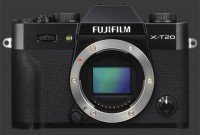
Fujifilm X-T20.
Like its precessor, the X-T30 offers a 0.39" EVF with 2.4 megapixels, 100% coverage, 0.62X maginification and an extremely useful Eye-Start sensor. As the mid-range offering among Fujifilm mirrorless, the X-T30 is not weatherproof nor freezeproof. The feature set of this upper-mid-range mirrorless camera is quite extensive. It offers plenty of advanced features such as 9-Frame AEB, Focus-Bracking and Cinema 4K video capture.
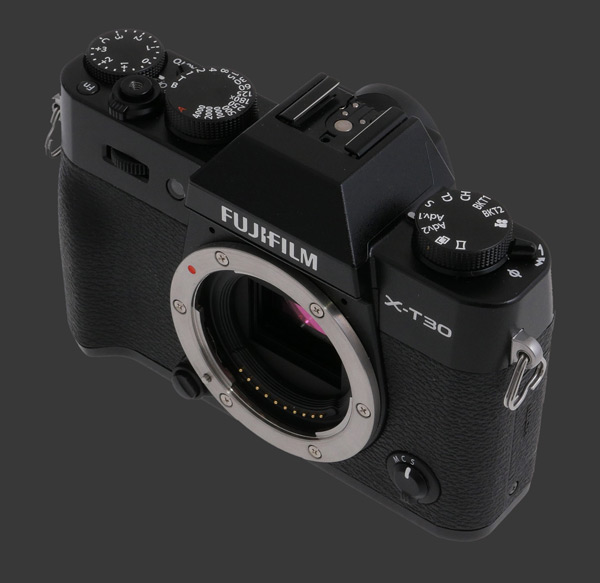
The X-T30 uses Fuji's own XF lens mount which has a very short flange distance. This makes it easier to design high-quality lenses and lens-mount adaptors, including one made by Fuji for the Leica M-mount. Fuji launched a total of 20 lenses by now. Plus, there are third-party lenses from Zeiss and Samyang now, plenty of options, besides long telephoto lenses.
This digital camera review analyses the performance and image quality of the Fuji X-T30.
Fujifilm X-T30 Features
Sensor
- 26 Megapixels CMOS sensor
- X-Trans 6x6 Color-Filter Array
- No Anti-Alias filter
- 1.5X Crop factor (APS-C)
- 3:2 Aspect ratio
- 2.1M Phase-Detect Pixels
- 100%, 200% or 400% Dynamic-Range
- Dynamic-Range Priority mode, 2 levels
- Fuji XF lens mount
- Dust-Reduction
Exposure
- ISO 160 to 12800 sensitivity range, 1/3 EV steps
- ISO 80, 25600 and 51200 expansion
- Auto ISO, Selectable maximum from 400 to 12800
- ISO Bracketing, 3 frames, 1/3-1 EV steps
- Hybrid Shutter:
- Mechanical: 1/8000s-15m
- Electronic: 1/32000-15m
- EFCS: 1/8000s-15m
- Mechanical + Electronic mode
- EFCS + Mechanical mode
- EFCS + Mechanical + Electronic mode
- Bulb exposure, maximum 1 hour
- Shutter-Speed Steps: 1/3 EV
- PASM Exposure modes
- Multi-Segment, Center-Weighed, Spot and Average metering
- Exposure-Compensation, ±5, 1/3 EV increments
- AEB, 9 frames, 1/3-3 EV increments
- Flash-Compensation, ±3, 1/3 EV increments
- Auto, Forced, Slow-Sync, Rear-Sync, Wireless and Off Flash modes
- Rear or Front Curtain Sync
- Optional Redeye Removal
Image Parameters
- Automatic, 7 presetsSunny, Shade, 3 Fluorescents, Incandescent, Underwater, Kelvin and Custom WB
- WB fine-tuning along 2 axis in 19 steps
- WB Bracking, 3 frames, 3 step sizes
- Film Simulation: Provia, Velvia, Astia, Classic Chrome, Pro Negative Hi, Pro Negative Standard, Eterna, Acros, B&W, Sepia
- Film Simulation Bracketing, 3 frames
- Adjustable Color, Sharpness and Noise Reduction, 9 steps each
- Adjustable Highlight Tone and Shadow Tone, 7 steps each
- Optional Chrome Color Effect
- Optional Lens Modulation Optimizer
- Optional Long-Shutter Noise Reduction
Focus
- Single-Shot or Continuous AF mode
- Single-Point, Zone or Wide AF selection
- Fine-Tunable Tracking AF-C:
- Tracking Sensitivity, 5 levels
- Speed Tracking, 3 levels
- Zone Switching, Auto, Center or Front
- Manual-focus (MF), Electronic Magnification
- Hybrid 425-Point Phase-Detect AF system
- Focus Bracketing, 2-999 Frames, 10 Step sizes, 0-10s Interval
- Optional DMF mode
- Optional Pre-AF
- Optional Digital Split Image
- Optional Digital Microprism
- Optional Focus Peaking
- Optional AF-Assist lamp
- Optional Face and Eye Tracking, 4 modes
- Fly-By-Wire focus-ring on most lenses
Drive
- Full-Resolution Continuous Drive:
- 20 FPS, Electronic Shutter: 32 JPEG or 17 RAW
- 10 FPS, Electronic, 81 JPEG or 17 RAW
- 8 FPS, Mechanical, 90 JPEG or 18 RAW
- 5 FPS with AF-C, Unlimited JPEG or 18 RAW
- 16 Megapixels 1.25X Crop Continuous Drive:
- 30 FPS, 26 JPEG or 17 RAW
- 20 FPS, 53 JPEG or 17 RAW
- 10 FPS, 95 JPEG or 18 RAW
- Blackout Free, 125% Coverage Preview
- Motion Panorama, Normal or Wide, 4 Directions
- Interval Timer, 1s-24h interval, 1-999 frames, 0m-24h delay
- Multiple-Exposure, 2 frames
- Self-timer, 2s or 10s
Video
- Cinema 4K: 4096x2160 @ 30 FPS, 100-400 Mbps
- Ultra-HD: 3840x2160 @ 30 FPS, 100-400 Mbps
- 2048x1080 @ 60 FPS Video, 50-200 Mbps
- 1920x1080 @ 60 FPS Video, 50-200 Mbps
- H.265 10-bit or H.264 8-bit codecs, All-Intra or Long GOP encoding
- Optional Clean HDMI Output, except 2048x1080
- Optional 4K Inter-Frame Noise-Reduction
- Optional F-Log recording
- Built-in Stereo Microphone
- Stereo line-in minijack
- Timecode Controls
Display & Viewfinder
- 0.39" EVF, 2.4 Megapixels, 0.62X Magnification
- 100% Coverage
- Eye-Start sensor
- 3" Tilting LCD, 1 Megapixel
- Tempered Glass Touchscreen
- Digital Level, 1-axis
- Depth-Of-Field Preview
- Depth-Of-Field Scale
- Optional Live-Histogram
- Optional Framing-Guides, 3 types
Output Processing
- 3:2 Native aspect ratio
- 16:9 and 1:1 cropped aspect ratios
- 24, 12 and 6 megapixels modes
- JPEG, RAW, RAW+JPEG capture
- 2 JPEG Compression levels
- Optional Lossless RAW Compression
Misc
- Dual control-dials
- Exposure-Compensation dial
- Customizable Rear Control-Dial
- Shutter-speed dial, full-stops only
- Aperture ring on lenses
- 3 Customizable Buttons
- Wired-Remote connector
- Standard Hot-Shoe
- Lithium-Ion battery
- USB-C 3.1 Port & Charging
- SDXC Slot, UHS-II Support
- 4K HDMI output
- Built-in WiFi
Fujifilm X-T30 Usability - How easy is it to use?
The Fujifilm X-T30 features a hybrid design that combines the dual control-dials of modern digital cameras and an analog shutter-speed dial, with aperture usually controlled by a dedicated ring around the lens. The compromises of this approach are detailed right on this review page.The X-T30 notably lacks a dedicated ISO dial, compared to the X-T3, yet it can be customized to control ISO directly via one of its control-dial.
This mirrorless digital camera is build upon a solid metal frame with hard rubber enveloping all but the bottom plate and upper portion of the body. The entire camera feels very solid with a confidence-inspiring weight. Fujifilm included a tiling LCD with a remarkably sturdy hindge and it is the only component that shows some flex. The upper part of the camera has a nice smooth finish over the metal base.
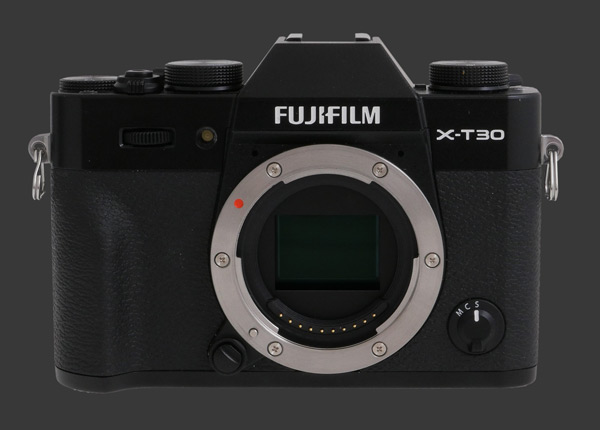
The X-T30 is surprisingly small given its large display and high number of external controls. There is a short and shallow grip to hold the camera by. Eyelets on both sides allow the use of a neck-strap which is highly recommended to keep the camera secure. The eyelet on the grip-side unfortunately digs uncomfortably into the index finger while reaching the shutter-release.
The front of the Fujifilm X-T30 shows a 3-way Focus-Mode switch a the lower-right. It selects between Manual, Continuous and Single focus. A Focus Menu option allows DMF during AF-S and can customize the behavior of AF-C, among many features of the autofocus system. The Lens Release is found at the lower-left of the lens mount. Above the grip, near the top of the camera, one can see the front control-dial. While the dial is physically the same as on the X-T20 and X-T10, its operation has been improved. It has distinct detents with a nice amount of resistance.
The front control-dial can control any exposure parameter plus EC. It can also control up to 3 of those 4 parameters! To cycle between parameters, the dial itself must be clicked inwards. This cycles over up to 3 parameters assigned to that control-dial via the Setting menu. A mininum of one parameters must be assigned and it must be either Aperture or Shutter-Speed. Both can be assinged too or other combinations. Aperture control is only applicable to lenses with either an A position to their aperture ring or no aperture-ring at all. Shutter-Speed is is usually applicable to select 1/3 stops directly or as Program Shift. ISO is always applicable and covers Auto options as well. The clever part is that the X-T30 automatically skips any non-applicable parameter, so by setting the front control-dial to Aperture and ISO with the third parameter set to None, one effectly gets direct ISO control nearly at all times.
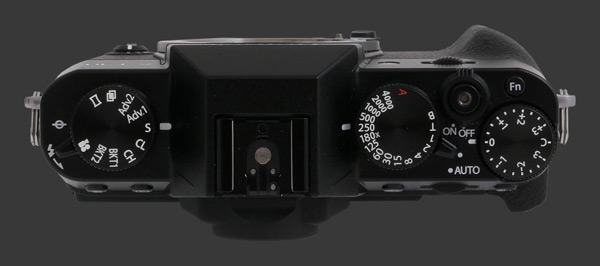
The top-plate is fairly occupied by analog dials. On the right side, there is a Drive-Mode dial. Since there is inusfficient room for all Drive Modes, six positions have a corresponding settings in the Camera menu to select their exact behavior. There are distinct positions for Single-Shot, Low Speed Continuous Drive, High-Speed Continuous Drive, Video, Motion Panorama and Multiple-Exposure. There are 2 Bracket and 2 Advanced positions too. The former access one of four bracketing modes: AEB, ISO Bracketing, WB Bracketing and Film Simulation Bracketing. The latter access each a different preselected Special Effect Filter. Having a dedicated Video mode means that the X-T30 can correctly preview framing for video and be ready to record, a crucial improvment over previous generations.
On the left side of the top plate, there is a Shutter-Speed and an Exposure-Compensation dial. The Shutter-Speed dial is marked in full-stops between 1/4000s and 1s. Both faster and slower shutter-speeds, plus 1/3 increments in between are selected via a control-dial. Either the front or rear one can be set to adjust shutter-speed. It is best though to leave it to the rear one, otherwise the front dial gets less efficient since it has to cycle over an additional exposure parameter. Speaking of increments, the Fuji only works in thirds as even most lenses have an aperture-ring with 1/3-stop clicks. The available shutter-speed range depents on the selected shutter type. On the completely electronic shutter can shoot faster than 1/8000s. Selecting a mode that automatically switches between shutter types is possible but it disables some camera features.
The Shutter-Speed dial has an automatic position marked A. Lenses also have an A position to set aperture automatically. On prime lenses, this is a distinct position of the aperture-ring. On most zooms, it is a switch. The Exposure-Mode is implicit by the positions of all these dials. This is the only way to control Exposure-Mode since there is no Mode-Dial on this mirrorless. Any accidental movement of these dials causes the mode to change. Of all those, lens aperture-rings are the most problematic and photographers must constantly check their state to avoid surprises.
The shutter-release is squeezed between the EC and Shutter-Speed dials. It is smaller than usual with a thread for an analog wired remote-release. The shutter-release has a moderate amount of travel with a firm halfway point. Note that this camera also supports an electronic wired remote-release via a 2.5m port behind one of the side flaps.
Right at the corner of the top-plate, there is a tiny customizable Fn button. It can be assigned to one of an incredible 50 functions! A quick tap activates the selected function, a long press allows that function to be changed without navigating through the menu system. At the base of the Shutter-Speed dia, there is now a switch that toggles between normal and fully automatic mode. In this automatic mode, the position of most dials is ignored. The last item to see on top is the standard hot-shoe that sits on top of the EVF housing.
The left side of the camera has a flexible plastic panel. Behind it are HDMI and USB-C connectors plus a mini-jack. The HDMI connector supports Ultra-HD output and the camera processor is now sufficiently powerful to record 4K to the SDXC memory card and output 4K via HDMI simultaneously. To save bandwidth, there is the option to downscale one of the two outputs to 1080p when recording 4K Ultra-HD. For Full HD, the camera offers an option to output via HDMI without recording the video to the memory-card. The USB-C port supports fast file transfers and charging but it cannot power the camera itself. Lastly, the mini-jack accepts stereo audio input or a wired remote trigger.
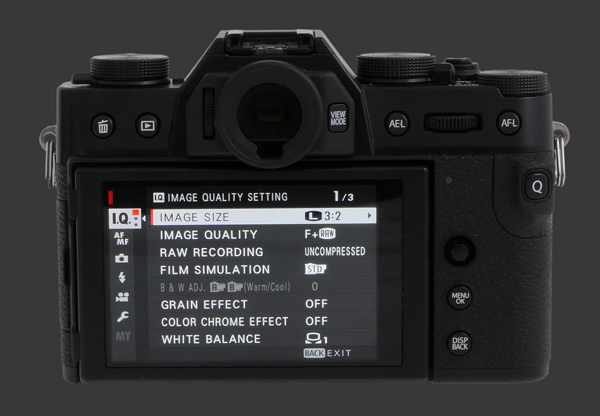
The Fujifilm X-T30 features a high number of controls on its back which is dominated by a wide 3" tilting LCD with one megapixel of resolution. Just above the LCD, there is a 0.39" EVF with 2.4 megapixels with a good 0.62X magnification. The LCD is sharp with fluid motion and decent but below average visibility. Luckily, the EVF is extremely sharp with nice contrast and a fast refresh rate. It shows the scene clearly even in rather low light. On one side of the EVF, there is a rotating diopter control. On the other, there is a button which cycles between Eye-Start Sensor modes: EVF, LCD or Automatic.
Where both displays falter is that they are only Exposure-Priority in Manual exposure. It's not understandable why one would knowingly show a misleading preview. The histogram follows the display so it is only accurate during Manual exposure.
The back of the camera features a number of buttons. Directly to the left of the EVF, there is a Delete and Playback button which work exactly as expected. Across from the viewfinder, there is a customizable AE-L button. The camera's rear control-dial is next to it. This dial as nice detents with moderate resistance, just like the front control-dial. This dial is also clickable and can activate one of the same 50 function available to the Fn button. A few functions such as MF Assist and DOF Preview have no other way to be accessed, so one must choose carefully how to configure the rear dial. Further right, there is an AF-L button. Both AE-L and AF-L can be customized to any of the same 50 parameters as the Fn button.
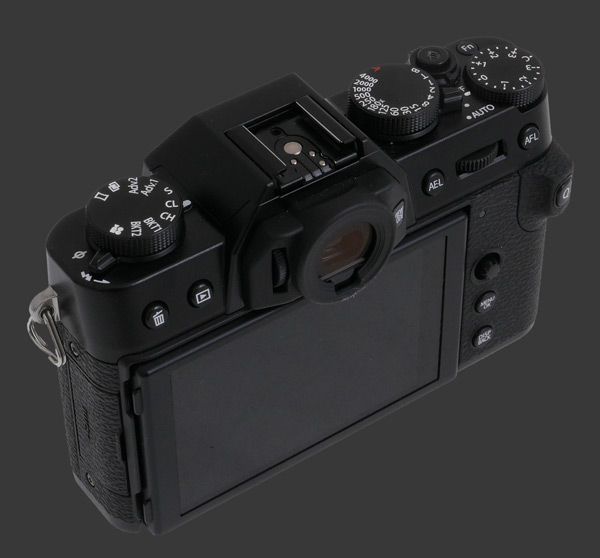
A Q button is found further down, just to the right of a small empty area to rest the thumb. Pressing Q brings up an iconic menu which gives quick access to 16 camera settings: Custom Setting, ISO, Dynamic-Range, WB, Noise-Reduction, Image Size, Image Quality, Film Simulation, Highlight Tone, Shadow Tone, Color, Sharpness, Self-Timer, AF-Point, Flash Mode and LCD Brightness.
The X-T30 adopts the 8-way Focus Joystick which replaces the traditional 4-way controller on most recent Fujifilm mirrorless digital cameras. It provides a very quick way to move the active focus-point or area around the frame. Pressing it resets focus to the center of the frame. This same joystick is used to navigate the standard menu system and the Q menu. A Menu button below the joystick serves to enter and exist the menu system, as well as confirm actions.
The last button on the back is the Disp/Back button which is used to cycle over display modes or cancel actions. Fujifilm provides 3 set display modes plus a customizable one for the LCD. With the EVF on, Disp toggles between normal and full view.
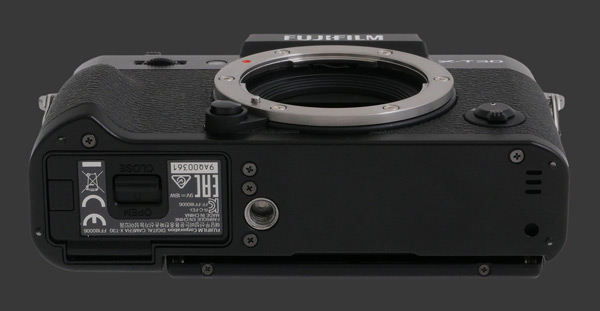
The bottom of the Fuji X-T30 has a metal tripod mount which is neither in-line with the optical axis nor with the center of gravity of the camera. There is also a sturdy plastic door which covers the combined memory-card and battery compartment.
The design of the X-T30, which is similar to that of the X-T3, is well-intended but has a some weaknesses. It really seems Fujifilm could have done better with the same number of controls. Just replacing the Shutter-Speed dial with an ISO one and letting the rear control-dial set shutter-speed over the entire range would have made all exposure parameters accessible with great simplicity. Although not an issue with the camera itself, the aperture ring on all Fuji X-mount lenses is still too soft. This causes images to easily be capture at the wrong aperture and, consequently, shutter-speed.
 |
Please Support Neocamera
All information on Neocamera is provided free of charge yet running this website is a huge endeavor. Purchases made via affiliate links found throughout the site help keep it running and up-to-date. There is no additional cost to you, so please consider buying via these links to our affilates:
If you found any information on this site valuable and did not purchase via our affiliate links, please considering donating via PayPal:
Any amount will be greatly appreaciated. Thank you for your support!
Fujifilm X-T30 Highlights

Sensor-Size: 24 x 16mm

Actual size when viewed at 100 DPI
| 26 Megapixels Mirrorless | ISO 80-51200 |
| Fujifilm X Mount 1.5X FLM | Shutter 1/32000-900s |
| 0.39" Built-in EVF 2.4 Megapixels (0.62X) | Full manual controls, including Manual Focus |
| Automatic Eye-Start sensor | Custom white-balance with 2 axis fine-tuning |
| 1 Axis Digital Level | Spot-Metering |
| Built-in Dust Reduction | Hot-Shoe |
| 20 FPS Drive, 32 Images | Stereo audio input |
| 4096x2160 @ 30 FPS Video Recording | Lithium-Ion Battery |
| 3" LCD 1 Megapixels | Secure Digital Extended Capacity |
Updates
2025.01.18

Fujifilm GFX 2025 Lens Roundup
Lens Review roundup of Fujifilm GFX Medium-Format lenses. Quality, performance and handling of the GF20-35mm F/4R WR, GF30mm F/3.5 Tilt-Shift and the GF55mm F/1.7.
2024.11.18

Best 2024 Photography Gifts for Every Budget
Great gifts for photographers and photo enthusiasts selected for every budget among the best products of 2024.
2024.08.07

Eye Protection Tips for Professional Photographers
The four main considerations for professional photographers regarding eyewear.
2024.07.14

Fujifilm X100VI Review
Flagship fixed-lens compact digital camera with a 40 MP sensor and Image-Stabilization, a first for the series. Retro design featuring dual control-dials, plus direct ISO, Shutter-Speed and EC dials. Its hybrid viewfinder can switch between EVF and OVF mode.
2024.05.09

Fujifilm GFX100 II Review
Flagship 102 Megapixels Medium-Format Mirrorless Digital Camera with 8-Stop 5-Axis IBIS, 8 FPS Drive, 8K Video and 400 MP Super-Resolution capture in a weatherproof and freezeproof body with dual control-dials and dual memory-card slots.
2024.04.03

Fujifilm X-T5 Review
Newest Fujifilm flagship boasting a 40 MP APS-C sensor, 5-axis IBIS with 7-stop efficiency, 15 FPS continuous drive, 6.2K Video capture, dual control-dials and dual SDXC UHS-II slots in a sturdy weatherproof and freezeproof body.
2023.11.20

Best Digital Cameras of 2023
Find out which are the Best Digital Cameras of 2023. All the new Mirrorless Digital Cameras from entry-level to high-end professional.
2023.07.10

Fujifilm X-H2 Review
40 Megapixels APS-C Hybrid Mirrorless Digital Camera with 7-stop IBIS. Fastest shutter ever and 8K video capture. Large builtin EVF with 0.8X magnification and 5.8 MP, plus an Eye-Start Sensor. Packed with features and large number of controls in a weatherproof and freezeproof body.
2023.05.07

Sony FE 20-70mm F/4G Review
Review of the unique Sony FE 20-70mm F/4G lens. The optical zoom of this lens spans ultra-wide-angle and medium focal-length coverage, making it one of the most versatile Full-Frame lenses on the market.
2023.01.15

Huion Inspiroy Dial 2 Review
Review of the Huion Inspiroy Dial 2 tablet, a medium sized drawing surface with dual dials and customizable buttons. Connects via USB-C or Bluetooth 5.0 with Windows, Linux and Android support.
2022.12.08

How to Pack for a Photo Trip
Find out how to pack for a travel photography trip, carry your gear safely while meeting airline regulations.
2022.11.13

Best Digital Cameras of 2022
The best digital cameras of 2022. A short list of the most outstanding models in their respective categories. Choose one for yourself or as a gift.













